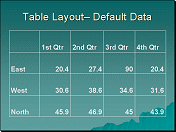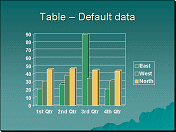 |
Many reports and discussions need to refer to tables of
information or charts. You will need to think carefully about how or whether to
include these in your presentation.
Problems with Tables & Charts
 Problem:
Tables of data do not show up very well on slides. You
cannot get very many cells on the slide without making them too small to read easily. Problem:
Tables of data do not show up very well on slides. You
cannot get very many cells on the slide without making them too small to read easily.
Problem: Too much information all at once means none of it is absorbed by
the audience.
 Problem:
Complex charts are hard to read on the screen. Text and bars or lines get
small. Problem:
Complex charts are hard to read on the screen. Text and bars or lines get
small.
Possible Solutions:
- Simplify: Show only the most important data.
- Divide data: Use several simple tables or charts on separate slides
instead putting all in one table or chart.
- Reveal in parts - Table: Create a separate table for each row or
column and arrange them on the slide to look like one table. Use custom
animation to reveal them one at a time.
- Reveal in parts - Chart: Reveal each
series or each category in turn instead of all at once, using Effects
Options for a custom animation.
- Notes: Put the complete table or chart in a Notes handout and just a summary
or highlights
on the slide.
|
 |

Where you are:
JegsWorks > Lessons > Presentations
Before you start...
Project 1: PowerPoint Basics
Project 2: PowerPoint Formatting
Project 3: Advanced PowerPoint
Outline
Images
Tables & Charts

 Table Table
 Chart Chart
 Import Data Import Data
 Animate
Data Animate
Data
Finishing
Summary
Quiz
Exercises
Search
Glossary
Appendix
|
|
Import Data
Problem: Lots of data means lots of typing to create a table or chart!
Solutions (when data is already in a document):
- Copy and Paste:
Data must already be in a table or chart in another program, like Word
or Excel.
Disadvantages:
- Can be edited
only in PowerPoint, with PowerPoint's tools
- Will not show any changes made to the original after you pasted.
- Import a file as an
object (Insert menu):
Advantage:
- Can edit with original program.
- If linked, the slide can be updated to
show recent changes.
- Spreadsheet: If the original has several sheets, you can pick which one shows on the slide. The rest is still there if you change your mind!
Disadvantage:
- Broken links: PowerPoint must be able to find the original file when
you update . If you moved
the presentation to a different computer or moved the data file to a new
location, the update will fail.
- Presentation size gets larger when inserting whole files instead of
just a data table or chart.
 


~~ 1 Cor. 10:31 ...whatever you do, do it all for the
glory of God. ~~
Last updated:
30 Apr 2012 |

